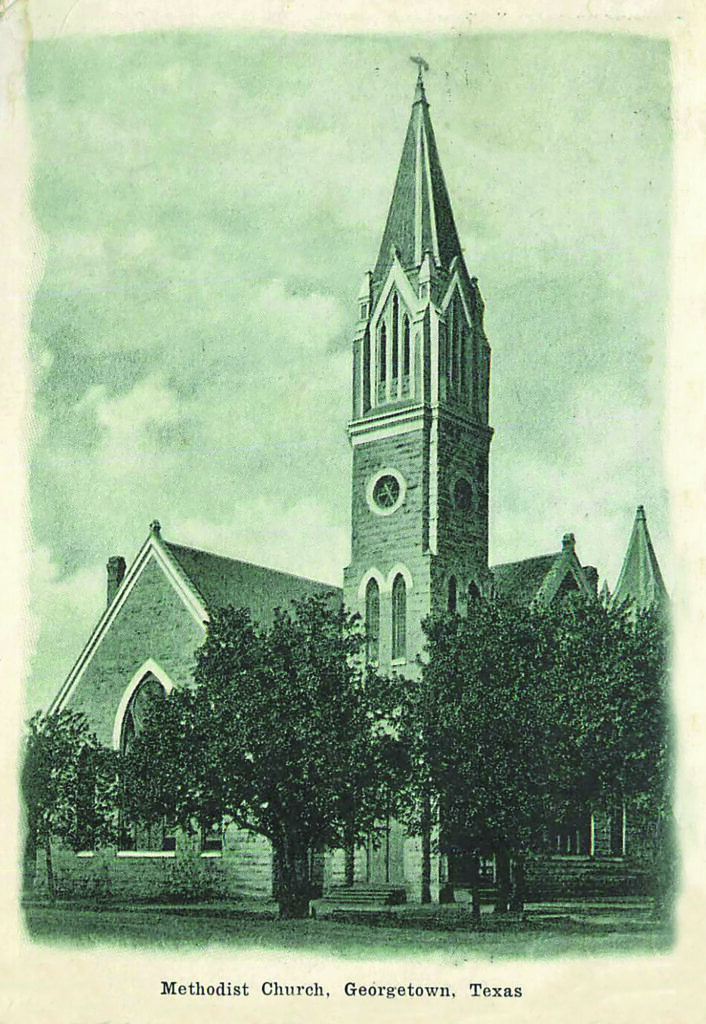First United Methodist Church Celebrates 175 Years
by Ann Marie Kennon & Charlotte Kovalchuk • photos courtesy Lisa Blake
Established just one year after the founding of Williamson County and Georgetown, First United Methodist Church Georgetown has been a long-time cornerstone of the community, embodying the biblical call of servanthood particularly towards the sick and prisoners. “We have records of women who were visiting the sick and prisoners, and serving the needs of the community in different ways from the 1800s,” Rev. Tina Schramme says. “It’s just really powerful to know that the church you’re a part of has done that for so long. It’s special because we know the impact this church and the people of this church have had on the community.”
175 YEARS OF FAITH AND COMMUNITY
The story of Georgetown’s First United Methodist Church begins in 1849 when James W. Lloyd was assigned to organize the Georgetown Mission Church. James arrived in the new town of Georgetown, established on uninhabited prairie land in 1848, as part of a Methodist effort to extend their mission into the expanding Texas frontier. At that time, Georgetown was a small hamlet with only a handful of log houses and no churches. Religious services were held in homes or public buildings, and the residents relied on visiting circuit preachers to perform baptisms, marriages, and funerals.

Despite the challenges of frontier life, the Georgetown Methodist Church grew slowly but steadily. By 1865, the church reported 180 white members and 24 black members. During the Civil War, the church, like many others in the South, faced difficulties, including the loss of pastors who joined the Confederate Army. After the war, Georgetown was included in the newly established Northwest Texas Conference, marking a new phase in its development.
The 1870s were pivotal for the town of Georgetown in general and the Methodist Church specifically. In 1870, a group of citizens began constructing Georgetown College, which later became Southwestern University. The college’s establishment was closely linked with the Methodist Church, and by 1873, the church reported an increase in membership. However, when Dr. Francis Asbury Mood, the first president of Southwestern University, arrived in Georgetown, he found only 14 active Methodists in town. The lack of an enthusiastic congregation was attributed to the absence of a dedicated meeting place and the challenges of frontier life.
In 1874, the Georgetown Methodist Church formally organized, holding services in the Southwestern University chapel. Over the next few years, the church and university grew together, with the church eventually constructing its own chapel in 1882. This simple building became the heart of the Methodist community, hosting not only religious services but also social and educational events.
By 1891, the church had outgrown its chapel, and plans were made to construct a new, larger sanctuary. The new Gothic Revival-style church, completed in 1893, became a prominent feature of Georgetown, symbolizing the growth and stability of the Methodist community in the town. The church continued to thrive, with various organizations, such as the Ladies Aid Society, playing a crucial role in supporting both the church and the broader Georgetown community. The church’s history reflects the resilience and commitment of its members, who overcame the challenges of frontier life to build a lasting spiritual and educational legacy in Georgetown.
From 1893 to 1924, Georgetown’s First United Methodist Church experienced significant growth and development, reflecting both the maturation of the congregation and the broader changes in the community.
The turn of the century saw the expansion of facilities, including a new pastor’s home in 1904 and the installation of a Pilcher pipe organ. The church’s influence extended even further with the creation of a new Georgetown District in 1910. In 1917, the church purchased additional property, sold its old chapel, and hosted the Central Texas Conference, highlighting its growing prominence in the region.
By the 1920s, Georgetown’s First United Methodist Church had firmly established itself as a central institution in the community. With a membership in the 700s, the church provided spiritual guidance, community support, and educational opportunities, ensuring its continued growth and influence in the decades to come.
Many of First United Methodist Church’s past and current members have been instrumental in shaping Georgetown, including Nettie Ruth Bratton, who helped start the Negro School of Fine Arts; Doug Benold, who started Georgetown’s first hospital; and George and Barbara Brightwell, who started The Georgetown Project. “The members of our church were very much the leaders of the community,” Tina says.
FUTURE FOCUS
Looking ahead, the church is planning a capital campaign to update its over-a-century-old campus and fund new projects, such as a second nursery space, and help meet the needs of the many young families joining the church. On October 20, First United Methodist Church will celebrate its 175th anniversary with two worship services and a church festival featuring bounce houses, food vendors, games, and arts and crafts.
To learn more about First United Methodist Church Georgetown, visit fumcgt.org.
